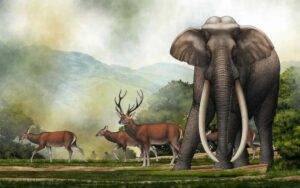
The giant fossil skull of an extinct elephant, discovered in northern India’s Kashmir Valley in 2000, sheds light on a poorly known episode in elephant evolutionary history.
The elephant skull was buried with 87 stone tools used by prehistoric humans, and all the materials were excavated under the leadership of Dr. Ghulam Bhat at the University of Jammu.
Recently, an international team of scientists from the Florida Museum of Natural History, the British Museum, the University of York, and the Natural History Museum (London), along with the University of Helsinki’s Dr. Steven Zhang, studied the Kashmir skull to uncover the age and evolutionary context of this megaherbivore. The paper is published in the Journal of Vertebrate Paleontology.
“From the general shape of the skull, it’s quite apparent that the elephant belonged to Palaeoloxodon, or straight-tusked elephants, among the largest land mammals that ever lived. Full-grown adults easily stood around 4m tall at the shoulder and weighed 9–10 tonnes,” says Zhang, a paleontologist from the University’s Department of Geosciences and Geography.
“Yet what’s puzzled experts for some time is that the Kashmir skull lacks a thickened, forward-projecting crest at the skull roof which typifies other Palaeoloxodon skulls found in India.”
Over recent decades, whether the developmental extent of this crest could tell apart different species of Palaeoloxodon and the relative position of these species on the evolutionary tree of elephants has remained controversial. However, recent research concluded that the skull crest in these extinct elephants became more prominent with developmental and sexual maturity. This means that, once specimens can be aged by examining their teeth, it would be possible to compare skulls from individuals with similar levels of maturity.
“From the size, the wisdom teeth and a few other telltale features of the skull, it is evident that the animal was a majestic bull elephant in the prime of its life, but the lack of a well-developed skull crest, particularly in comparison with other mature male skulls from Europe and from India, tells us we have a different species on our hands here,” Zhang explained.
Instead, the research team noticed how the Kashmir skull’s features conform best with another obscure skull from Turkmenistan studied in the 1950s, which was proposed to represent a distinct species, Palaeoloxodon turkmenicus.
“What’s always been puzzling about the Turkmen skull is that, besides the lack of a prominent crest at the skull roof, its other features are highly similar to the already well-known European species, P. antiquus. And this led a number of experts to suggest that the Turkmen specimen is simply an aberrant individual of the European species,” says Zhang.
“But with the Kashmir skull added to the mix, it becomes clear now that the two specimens can be theorized to represent a distinct species that we previously knew very little about, with a broad distribution from Central Asia to the northern Indian Subcontinent,” added Dr. Advait Jukar, the study’s lead author, currently based at the Florida Museum of Natural History.
By measuring protein decomposition in the tooth enamel of the Kashmir Palaeoloxodon skull, and examining stone tools buried alongside the elephant remains, the team concluded that the Kashmir skull dates to the Middle Pleistocene period 300,000–400,000 years ago, very similar to the estimated age of the Turkmen skull. This supports the belief that the two skulls represent a species distinct from other Eurasian Palaeoloxodon.
Palaeoloxodon first evolved in Africa around 1 million years ago; this early African form had a narrow, convex forehead and underdevelopment of the skull crest. Later Palaeoloxodon, best-known from fossils discovered in Europe and India, have very wide, flattened forehead often associated with a thick crest that juts forward from the roof of the skull.
The team thus concluded that with a wide, flat forehead with only the faintest trace of a skull crest, P. turkmenicus may represent a poorly-known missing link that fills a gap in our understanding of how these prodigious prehistoric megaherbivores evolved.
Reference:
Advait M. Jukar et al, A remarkable Palaeoloxodon (Mammalia, Proboscidea) skull from the intermontane Kashmir Valley, India, Journal of Vertebrate Paleontology (2024). DOI: 10.1080/02724634.2024.2396821
Note: The above post is reprinted from materials provided by University of Helsinki.










